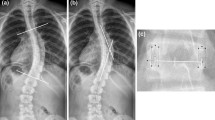Abstract
Study Design
After placing a thoracic three-vertebra segment saw bones model on a standardized turntable, a series of anteroposterior (AP) radiographs were obtained and then set in increments to 90° rotation. Then the specimen was instrumented with 35-mm pedicle screws bilaterally and the rotation process and image acquisition were repeated.
Objective
Assess reliability and accuracy of spine surgeons evaluating apical vertebral rotation (AVR) through surgeon’s visual x-ray estimation, Nash-Moe system, Upasani trigonometric method, and Upasani grading system.
Background Context
Accurate assessment of AVR is one measure surgeons can evaluate the success of intervention and potential loss of correction in scoliotic deformities.
Methods
Eighty-four representative images of uninstrumented and instrumented vertebral segments were blinded. AVR was estimated by five experienced spinal deformity surgeons using the four techniques. The surgeons’ grading, estimates, and errors compared to actual rotation were calculated. Inter- and intraobserver reliability were calculated using interclass correlation (ICC).
Results
Each surgeon’s error for simple visual estimation for uninstrumented segments was 8.7° to 17.4° (average error = 12.4°), and for instrumented segments it was 7.7° to 11.3° (average error = 9.5°). Error for the Upasani trigonometric method was −6.7° to 11.6° (average error = 0.9°). There was relatively poor accuracy for Nash-Moe system (38.2%–53.9%) compared with the Upasani grading system (76.74%–80.23%). Interobserver reliability using the Nash-Moe method was good (0.844), with intraobserver reliability from fair to excellent (0.684–0.949). Interobserver reliability for the Upasani grading method was good (0.829), with intraobserver reliability from fair to good (0.751–0.869). We found excellent interobserver reliability for Upasani trigonometric classification (0.935) with fair to excellent intraobserver reliability (0.775–0.991). The interobserver reliability of surgeons’ visual estimates was good (0.898) and the intraobserver reliability from good to excellent (0.866–0.99) without pedicle screws, and interobserver reliability was excellent (0.948) and intraobserver reliability also excellent (0.959–0.986) with pedicle screws.
Conclusions
We confirm that both techniques described by Upasani have good reliability and accuracy, appearing more accurate than surgeon’s visual estimates or Nash-Moe system.
Level of Evidence
Level III.
Similar content being viewed by others
References
Vo QN, Lou EH, Le LH. Measurement of axial vertebral rotation using three-dimensional ultrasound images. Scoliosis 2015;10(Suppl 2):S7.
Aaro S, Dahlborn M. The longitudinal axis rotation of the apical vertebra, the vertebral, spinal, and rib cage deformity in idiopathic scoliosis studied by computer tomography. Spine (Phila Pa 1976) 1981;6:567–72.
Birchall D, Hughes DG, Hindle J, et al. Measurement of vertebral rotation in adolescent idiopathic scoliosis using three-dimensional magnetic resonance imaging. Spine (Phila Pa 1976) 1997;22: 2403–7.
Cobb J. Outline for the study of scoliosis. Am Acad Orthop Surg Instr Course Lect 1948;5:261–75.
Nash CL, Moe JH. A study of vertebral rotation. J Bone Joint Surg Am 1969;51:223–9.
Perdriolle R, Vidal J. Thoracic idiopathic scoliosis curve evolution and prognosis. Spine (Phila Pa 1976) 1985;10:785–91.
Ho EK, Upadhyay SS, Ferris L, et al. A comparative study of computed tomographic and plain radiographic methods to measure vertebral rotation in adolescent idiopathic scoliosis. Spine (Phila Pa 1976) 1992;17:771–4.
Ho EK, Upadhyay SS, Chan FL, et al. New methods of measuring vertebral rotation from computed tomographic scans. An intraob-server and interobserver study on girls with scoliosis. Spine (Phila Pa 1976) 1993;18:1173–7.
Upasani VV, Chambers RC, Dalal AH, et al. Grading apical vertebral rotation without a computed tomography scan: a clinically relevant system based on the radiographic appearance of bilateral pedicle screws. Spine (Phila Pa 1976) 2009;34:1855–62.
Carrasco JL, Phllips BR, Puig-Martinez J, et al. Estimation of the concordance correlation coefficient for repeated measures using SAS and R. Comput Methods Programs Biomed 2013;109:293–304.
Fleiss JL, Cohen J. The equivalence of weighted kappa and the intra-class correlation coefficient as measures of reliability. Educ Psychol Meas 1973;33:613–9.
Fleiss JL. Reliability of measurement. In: Design and Analysis of Clinical Experiments. New York, NY: John Wiley & Sons, Inc.; 2011. p. 1–32.
Kuklo TR, Potter BK, Schroeder TM, O’Brien MF. Comparison of manual and digital measurements in adolescent idiopathic scoliosis. Spine (Phila Pa 1976) 2006;31:1240–6.
Kuklo TR, Potter BK, Lenke LG. Vertebral rotation and thoracic torsion in adolescent idiopathic scoliosis: what is the best radiographic correlate? J Spinal Disord Tech 2005;18:139–47.
Behensky HH, Cole AA, Freeman BJ, et al. Fixed lumbar apical vertebral rotation predicts spinal decompensation in Lenke type 3C adolescent idiopathic scoliosis after selective posterior thoracic correction and fusion. Eur Spine J 2007;16:1570–8.
Sugimoto Y, Tanaka M, Nakanishi K, et al. Predicting intraoperative vertebral rotation in patients with scoliosis using posterior elements as anatomical landmarks. Spine (Phila Pa 1976) 2007;32:E761–3.
Author information
Authors and Affiliations
Corresponding author
Additional information
Author disclosures: SVM (none), NROrdway (grants from Premier Orthopedic Solutions, outside the submitted work), DAA (none), SK (none), DW (none), VMS (none), RAT (personal fees from Stryker, grants from Vertiflex, outside the submitted work), DAK (other from AAOS, American College of Surgeons, Bristol-Myers Squibb, Eli Lilly, GlaxoSmithKline, Johnson & Johnson, Merck, Novartis, Procter & Gamble, Roche, and Sanofi-Aventis, outside the submitted work), KP (none), MP (personal fees from Stryker, Globus, Orthofix, Spineart, and Various Law Firms, outside the submitted work), WFL (other from SAS, Prosydian, Innovasis, 4Web, and Cardan Robotics; grants from DePuy Spine, Signus, Spinal Kinetics, K2M, Vertebral Technologies, Synthes Spine, Medtronic, IntegraLife, Providence Technologies, Stryker, Vertiflex, and Amedica, outside the submitted work).
This study required no IRB approval.
Rights and permissions
About this article
Cite this article
Marawar, S.V., Ordway, N.R., Auston, D.A. et al. Assessment of Inter- and Intraobserver Reliability and Accuracy to Evaluate Apical Vertebral Rotation Using Four Methods: An Experimental Study Using a Saw Bone Model. Spine Deform 7, 11–17 (2019). https://doi.org/10.1016/j.jspd.2018.06.009
Received:
Revised:
Accepted:
Published:
Issue Date:
DOI: https://doi.org/10.1016/j.jspd.2018.06.009




